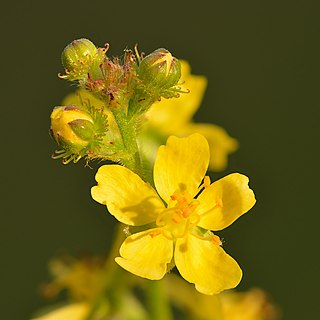
Agrimonia, commonly known as agrimony, is a genus of 12–15 species of perennial herbaceous flowering plants in the family Rosaceae, native to the temperate regions of the Northern Hemisphere, with one species also in Africa. The species grow to between 0.5–2 m (1.6–6.6 ft) tall, with interrupted pinnate leaves, and tiny yellow flowers borne on a single spike.
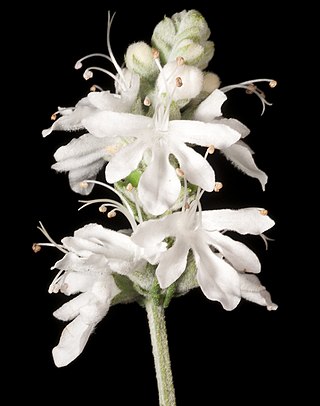
Teucrium is a cosmopolitan genus of flowering plants in the family Lamiaceae, commonly known as germanders. Plants in this genus are perennial herbs or shrubs, with branches that are more or less square in cross-section, leaves arranged in opposite pairs, and flowers arranged in thyrses, the corolla with mostly white to cream-coloured, lobed petals.

Calotropis is a genus of flowering plants in the family Apocynaceae, first described as a genus in 1810. It is native to southern Asia and North Africa.

Viburnum lantana, the wayfarer or wayfaring tree, is a species of Viburnum, native to central, southern and western Europe, northwest Africa, and southwestern Asia. The vigorous deciduous European treelike shrub is common along waysides.

Eupatorium cannabinum, commonly known as hemp-agrimony, or holy rope, is a herbaceous plant in the family Asteraceae. It is a robust perennial native to Europe, NW. Africa, Turkey, Syria, Iran, Iraq, Jordan, the Caucasus and Central Asia. It is cultivated as an ornamental and occasionally found as a garden escape in scattered locations in China, the United States and Canada. It is extremely attractive to butterflies, much like buddleia.

Agrimonia eupatoria is a species of agrimony that is often referred to as common agrimony, church steeples or sticklewort.

Draba verna, common whitlowgrass, is a species of plant in the cabbage family. It is a small spring-flowering annual which is widely dispersed around the world, and which is found on walls, pavements and patches of bare ground. It has a complex taxonomy which is not yet fully elucidated.

Rubus armeniacus, the Himalayan blackberry or Armenian blackberry, is a species of Rubus in the blackberry group Rubus subgenus Rubus series Discolores Focke. It is native to Armenia and Northern Iran, and widely naturalised elsewhere. Both its scientific name and origin have been the subject of much confusion, with much of the literature referring to it as either Rubus procerus or Rubus discolor, and often mistakenly citing its origin as western European. Flora of North America, published in 2014, considers the taxonomy unsettled, and tentatively uses the older name Rubus bifrons.

Norfolk Roadside Nature Reserve is a scheme which was set up in the mid-1990s by collaboration between the Norfolk County Council and the Norfolk Wildlife Trust. The aim of this scheme is to protect and promote the verges of Norfolk's roadside, that contain rare and scarce plant and insect species. Many of Norfolk's roadside verges have survived modern road improvements and as such are remnants of the natural grassland habitats that were once common and widespread in the British Isles. There are currently 67 such sites around the Norfolk countryside, but more are added each year. Once each year every Roadside Nature Reserve is surveyed and recorded by a dedicated group of volunteers from the trust. Demarcation posts are sited at each end of the Reserves.

Laurelia novae-zelandiae, also called pukatea, is a large evergreen tree, endemic to the forests of New Zealand. Pukatea has 'toothed' leaves and produces small flowers. It is a species in the Atherospermataceae family, typical representative of laurel forest ecoregion.

Galium aparine, with common names including cleavers, clivers, catchweed, robin-run-the-hedge, and sticky willy, is an annual, herbaceous plant of the family Rubiaceae.
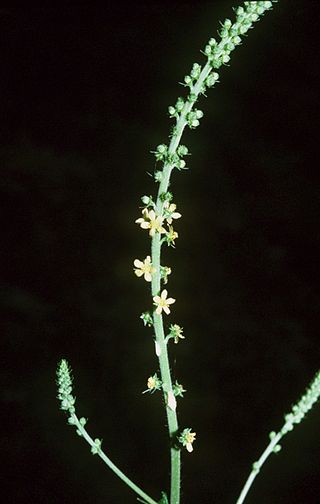
Agrimonia parviflora is a species of perennial herbaceous flowering plant. Small-flowered agrimony, harvestlice agrimony, swamp agrimony, and harvestlice are its most common names in the United States.
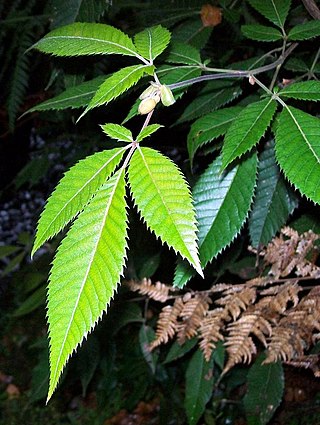
Vesselowskya venusta is a rainforest plant of restricted distribution from eastern New South Wales, Australia. The common name is Barrington Tops marara. The species name venusta is from the Latin, meaning "charming". Referring to the beauty of the long flower stems. The genus is named after the Russian botanist E. Vesselowsky.

Mallotus philippensis is a plant in the spurge family. It is known as the kamala tree or red kamala or kumkum tree, due to the fruit covering, which produces a red dye. However, it must be distinguished from kamala meaning "lotus" in many Indian languages, an unrelated plant, flower, and sometimes metonymic spiritual or artistic concept. Mallotus philippensis has many other local names. This kamala often appears in rainforest margins. Or in disturbed areas free from fire, in moderate to high rainfall areas.

Agrimonia gryposepala is a small perennial flowering plant of the rose family (Rosaceae), which is native to North America. This plant was used by various indigenous peoples to treat medical problems such as diarrhea and fever.

Mertensia paniculata, also known as the tall lungwort, tall bluebells, or northern bluebells, is an herb or dwarf shrub with drooping, bright-blue, bell-shaped flowers. It is native to northwestern North America and the Great Lakes.

Rubus flagellaris, the northern dewberry, also known as the common dewberry, is a North American species perennial subshrub species of dewberry, in the rose family. This dewberry is distributed across much of Canada, Mexico, and the United States. It grows in diverse habitats ranging from drier savannas to temperate deciduous forests.
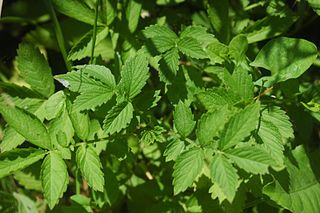
Agrimonia pilosa also known as hairy agrimony, is a flowering plant in the family Rosaceae. It is distributed primarily over the Korean Peninsula, Japan, China, Siberia, and Eastern Europe.

Myrica caroliniensis is a shrub or small tree native to the coast and coastal plains of southeastern North America. Its common names include bayberry, southern bayberry, pocosin bayberry, and evergreen bayberry. It sees uses in the garden and for candlemaking, as well as a medicinal plant.
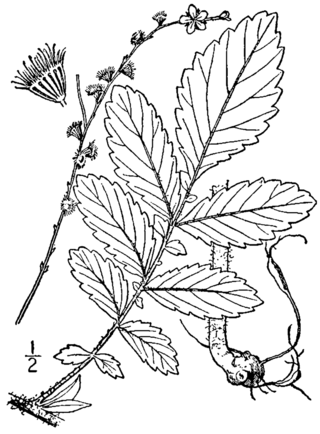
Agrimonia pubescens, the soft agrimony or downy agrimony, is a flowering plant in the genus Agrimonia, a member of the rose family. It grows in dry areas and woodlands.






















